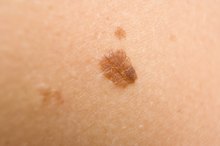Why Do Moles Grow Black Hair?
Whether you call it a mole or a beauty mark, many people consider a pigmented spot or bump less beautiful when hair seems to be growing out of it. Pigmented spots and bumps are formed by a type of cell found in the skin called a melanocyte. These pigment-producing cells give our skin its color, and when groups of melanocytes cluster together in large numbers, they produce a small darker area, often raised, known as a common mole 1. If a hair follicle happens to be in the midst of the clustered melanocytes, the mole will appear to sprout hair, which can be black or other colors. The hair is actually coming from the follicle -- it is not produced by the mole itself.
Significance of Hairy Moles
Many people have heard that a mole with hair is more likely to become cancerous than other moles or that removing the hair can cause or trigger cancer. There is no scientific evidence for these statements. Because hair is produced by an entrapped hair follicle and not the mole itself, neither the presence of hair nor the process of removing it has any affect on whether the mole will develop into a cancer. Other features of a mole, however, can indicate a higher risk of melanoma, so it's important to bring any unusual or changing mole to your doctor's attention.
- Many people have heard that a mole with hair is more likely to become cancerous than other moles or that removing the hair can cause or trigger cancer.
When to See a Doctor
How to Remove Facial Hair Growing Out of Moles
Learn More
Regardless of whether your mole has hair, it's wise to keep an eye on it and look for the "ABCDE" signs that might indicate cancerous changes. See your doctor if you notice that your mole has an asymmetric appearance, irregular borders, color variation or unusual coloring, diameter larger than the size of a pencil eraser or evolution. Evolution refers to changes, such as itching, bleeding, crusting or increasing size. You should also visit your doctor if a new mole appears after your 30th birthday.
- Regardless of whether your mole has hair, it's wise to keep an eye on it and look for the "ABCDE" signs that might indicate cancerous changes.
- See your doctor if you notice that your mole has an asymmetric appearance, irregular borders, color variation or unusual coloring, diameter larger than the size of a pencil eraser or evolution.
- Evolution refers to changes, such as itching, bleeding, crusting or increasing size.
Related Articles
References
- Fitzpatrick's Dermatology in General Medicine, 8th edition; Lowell A. Goldsmith, Stephen I. Katz, Barbara A. Gilchrest, Amy S. Paller, David J. Leffell, Klaus Wolff
- Merck Manuals: Moles
- Melanoma Education Foundation: About Melanoma -- How Does It Start
- National Cancer Institute. Common moles, dysplastic nevi, and the risk of melanoma. Updated April 27, 2018.
- American Academy of Dermatology. Moles: Overview.
- American Academy of Dermatology. Moles: Who gets and types.
- American Cancer Society. Tests for melanoma skin cancer. Updated August 14, 2019.
- American Cancer Society. Can melanoma skin cancer be prevented? Updated August 14, 2019.
- American Cancer Society. Key statistics for melanoma skin cancer. Updated January 8, 2020.
- Cleveland Clinic. Q&A Freckles and your skin.
- Cleveland Clinic. How to get rid of age spots (liver spots) and avoid more. March 12, 2020.
- American Academy of Dermatology. 5 reasons to see a dermatologist for mole, skin tag removal.
Writer Bio
Sunny has been a freelance editor since 1988 for dozens of publishers.









